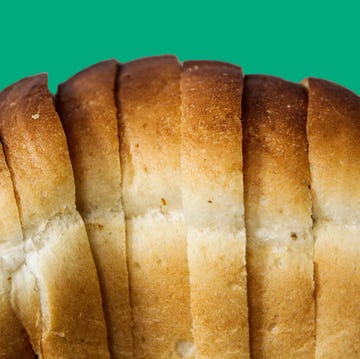If you're on a weight loss journey, you've probably wondered how to lose stomach fat at some point. It’s understandable to want to lose weight in a specific area of your body—however, unfortunately, it is not possible to spot-reduce body fat. So, what should you do if you still want to lose weight around your midsection without going on a totally restrictive diet?
First, know that it’s your entire body weight you’re targeting, not just your belly—and the weight loss process isn’t one-size-fits-all. “People genetically store weight differently,” says dietitian Albert Matheny, RD. “You may gain weight in different areas and, when you go to lose weight, you’re simply losing the [general] fat that’s stored.” In other words, you can’t tell your body to only drop weight in specific areas.
Ultimately, weight loss comes down to a combination of factors like diet, exercise, and genetics. But if you’re exercising and staying in a calorie deficit, you’ll likely lose weight around your midsection, too, Matheny says. Other lifestyle changes, like drinking less and reducing sugar intake, can also help speed up the process, he says.
If you're looking to lose tummy weight and strengthen your core, here are tips and tricks for how to do it safely, from dietitians.
Meet the experts: Albert Matheny, RD, is a dietitian and a co-founder of SoHo Strength Lab and Promix Nutrition. Jessica Cording, RD, is a dietitian and the author of The Little Book of Game-Changers.
How To Lose Stomach Fat
It's natural to carry excess weight around your midsection. That said, belly fat—also known as abdominal or visceral fat—has been linked to an increased risk of high blood pressure, heart disease, and type 2 diabetes, per the Centers for Disease Control and Prevention (CDC). If your doctor recommends weight loss, here are some practical tips to lose stomach fat safely and effectively.
1. Manage your stress levels.
Having higher levels of the stress hormone cortisol has been shown to promote accumulation of fat tissue around the midsection, says Cording. Although managing your stress is easier said than done, incorporating more stress relief practices into your daily and weekly routine may help your body work with you, not against you, as you aim for weight loss. Consider taking up mindfulness meditation, yoga, or seeing a mental health professional for tips on how you can better manage your stress.
2. Cut back on alcohol.
If losing belly weight is your goal, limiting or moderating alcohol intake can support weight loss. Many alcoholic drinks are high in sugar, calories, and could interfere negatively with your metabolism, research has shown. Drinking light to moderate amounts of alcohol isn't necessarily linked to weight gain, some studies have shown—but drinking alcohol can still be a risk factor for being overweight.
Alcohol can lower your inhibitions and raise the odds you’ll reach for less healthy food when you’re under the influence, Cording says. If you do decide to enjoy a glass of wine or margarita on the weekend, it's best to stick with the U.S. Dietary Guidelines for Americans, which recommend that adults of legal drinking age drink in moderation (two drinks a day or less for men, and one or less daily for women).
3. Reduce or moderate your sugar intake.
Sugar isn’t great for your overall health—or your weight. Diets that are high in sugar have been shown to increase obesity, and slowing down your sugar intake can be beneficial for weight loss, per a recent study. Cutting back on obvious forms of sugar (think: sweets, soda) can help you reach your fitness goals, Cording says.
Sneakier forms of sugar—like fruit juices—can also add extra calories and mess with your blood sugar, Cording says. When you drink juice, it converts into sugar in your body, and if you don’t have it with sources of fat or protein at the same time, it can cause a blood sugar crash afterward, leaving you feeling hungry. Ultimately, this can cause you to eat more, she explains. So, skip the fancy green juice in morning if you can help it, or at least pair it with a quality protein or healthy fat like a slice of avocado toast topped with a fried egg.
4. Prioritize quality sleep.
In addition to eating balanced, nourishing meals, getting enough sleep can also support your weight loss efforts. People who get less than seven to twelve hours of shut-eye per night tend to consume more calories (and opt for not-so-healthy food options) than those who get more sleep, per a study published in the European Journal of Clinical Nutrition. If you can, strive to get the recommended seven-plus hours of ZZZs a night.
5. Consider a calorie deficit.
Practicing a calorie deficit (burning more calories than you consume) could help reduce belly fat, Cording says. If you’re curious about exactly how many calories you should consume to lose weight or maintain your current weight, this body weight planner from the National Institutes of Health (NIH) might help. It asks you about your weight, lifestyle habits, weight loss goal, and how soon you'd like to reach it—then, it gives you a goal calorie amount to hit every day to lose weight.
“You want to create a deficit of input vs. output," says Matheny. Generally speaking, this pattern can help you drop belly fat—but always consult your healthcare provider, a registered dietitian, or both before starting a new diet plan on your own.
6. Eat more fiber.
Fiber helps fill you up and keep your digestion regular, Cording says. Adults with a high-fiber diet tend to lose weight faster than those who don't get enough fiber, per a study published in the Annals of Internal Medicine. Individual needs vary, but in general, women can aim for 25 grams of fiber per day, according to the NIH. There are many high-fiber foods to choose from, like lentils, berries, avocados, and chia seeds.
7. Incorporate walking into your routine.
It turns out that walking for weight loss is legit, and increasing your step count can be a great way to drop pounds, says Matheny. Although you can't technically target belly fat by itself, walking for 50 to 70 minutes three times a week for 12 weeks may help women lose belly fat, per a study published in The Journal of Exercise Nutrition and Biochemistry. If the weather is nice, lace up your walking shoes and get outside—or opt for a desk treadmill to help boost your step count.
8. Avoid processed foods and simple carbs.
Processed foods like chips, candy, cookies can add extra calories to your diet, fast. They can also increase the level of inflammation in your body, which raises your risk of developing body fat, including around your belly area, says Cording. Opt for fresh, whole foods whenever you can.
White bread, pasta, and cereals can also cause your blood sugar to spike and then drop, Cording says. The result? You can end up feeling hungrier and then eat more than you normally would. Try to focus on complex carbs instead, like whole-grain breads.
9. Try interval workouts.
Intervals workouts like HIIT help get your heart rate up fast and burn more calories, per Matheny. Try working your way through intervals that combine cardio with strength training for maximum benefits, like battle ropes alongside pull-ups, push-ups, jumping jacks, burpees, and planks.
What about sit-ups and crunches? Contrary to the myth that daily crunches will give you rock-hard abs, these workouts don't really burn visceral fat, which is stored deep inside the belly and wraps around your organs. To get to that layer, you'll need to lower your overall body fat by making changes to your diet and performing moderate-intensity physical activity, Matheny says.
10. Take up strength training.
If you're on a weight loss journey, strength training can be a great way to feel empowered and tone up. Plus, there's science behind weight training for weight loss, Matheny says. “It’s easy to lose weight when you have muscle mass—muscle is what burns the most calories outside of your base metabolic rate,” Matheny says. “The more muscle you have, the more additional calories you can burn.”
Even if you're a beginner, starting a simple weight training routine can help. You can start small and incorporate arm exercises into your existing routine, for instance, or get creative and wear Bala bangles while cleaning the house. A little goes a long way.
11. Eat more protein and healthy fats.
Protein can help boost your metabolism, improve satiety, and decrease fat mass, per research. Because protein tends to be filling, you may be less likely to overeat, which can contribute to weight gain, Cording says. Try adding lean meats (like grilled chicken and fish) to your diet and enjoy protein-packed snacks throughout the week. To stay fuller for longer, you should also incorporate healthy fats into your meals like nuts and avocados, Cording says.
If you’re wondering how much protein you really need to eat throughout the day, consider talking to a dietitian or using an online calculator to determine your needs.
Ashley Martens is a wellness writer based in Chicago. With a lifelong passion for all things health and wellness, Ashley enjoys writing about topics to help people live happier and healthier lives. With a foundation in fitness, food, and nutrition, Ashley covers it all including sexual health and travel topics. Ashley is also a NASM-certified personal trainer and group fitness instructor.












